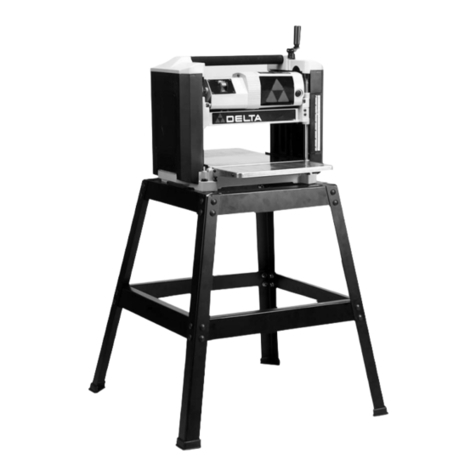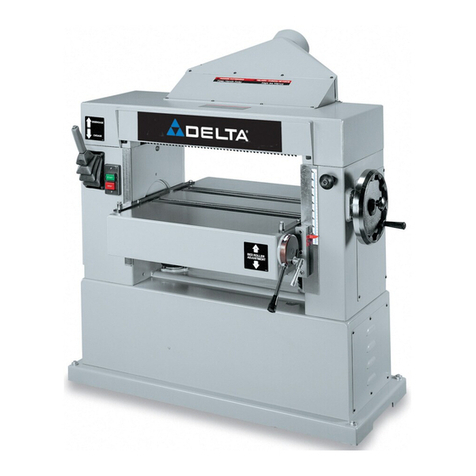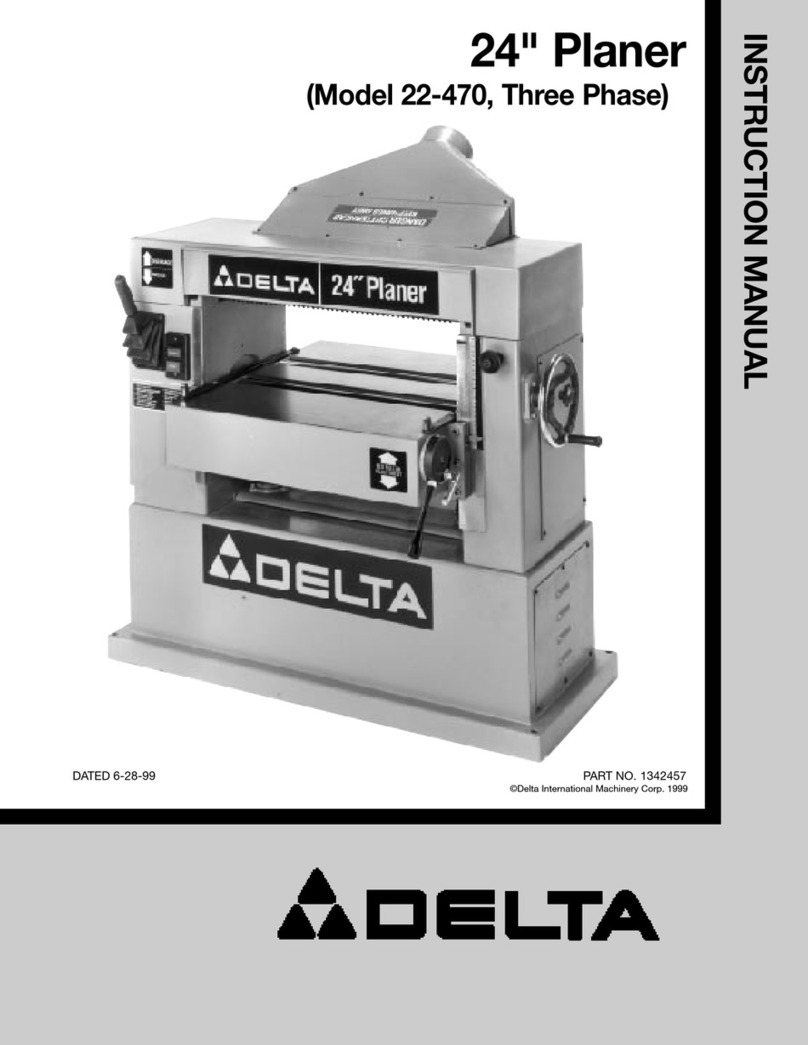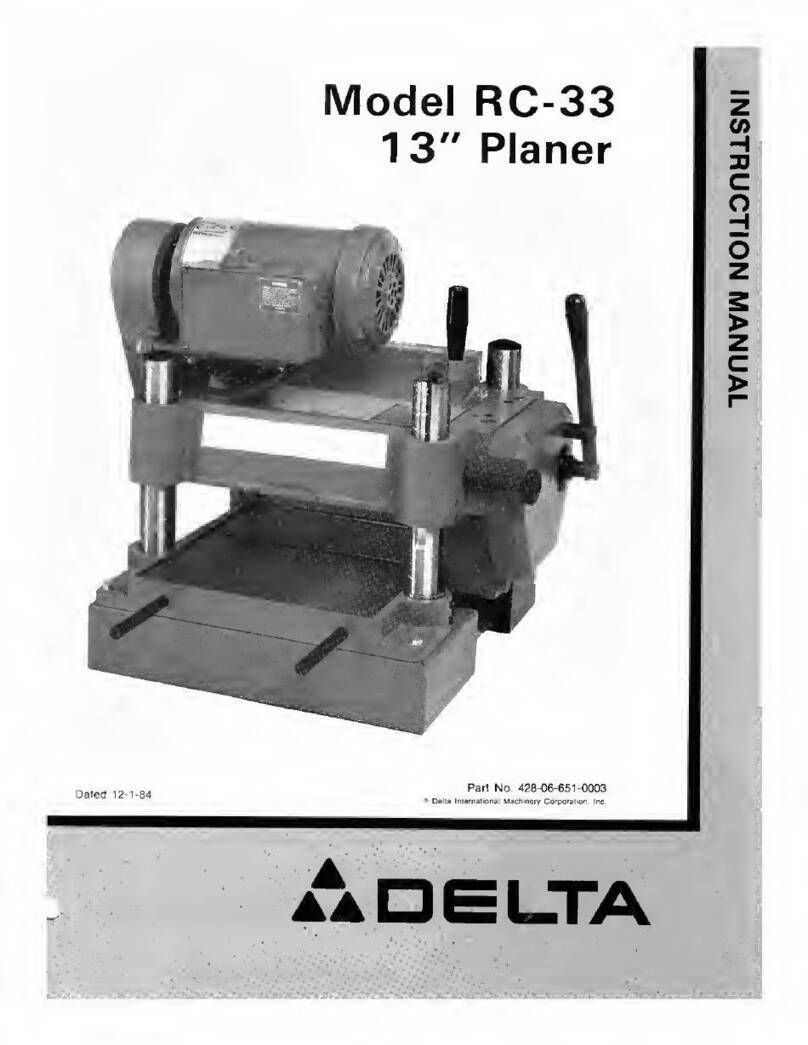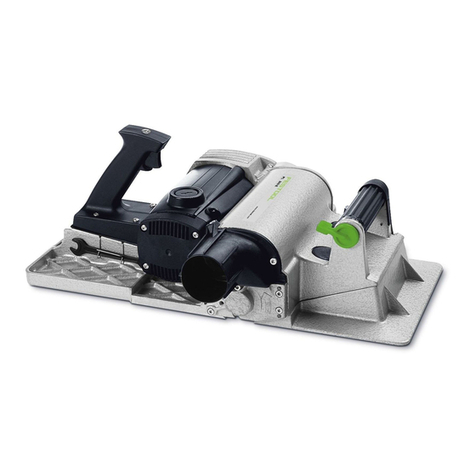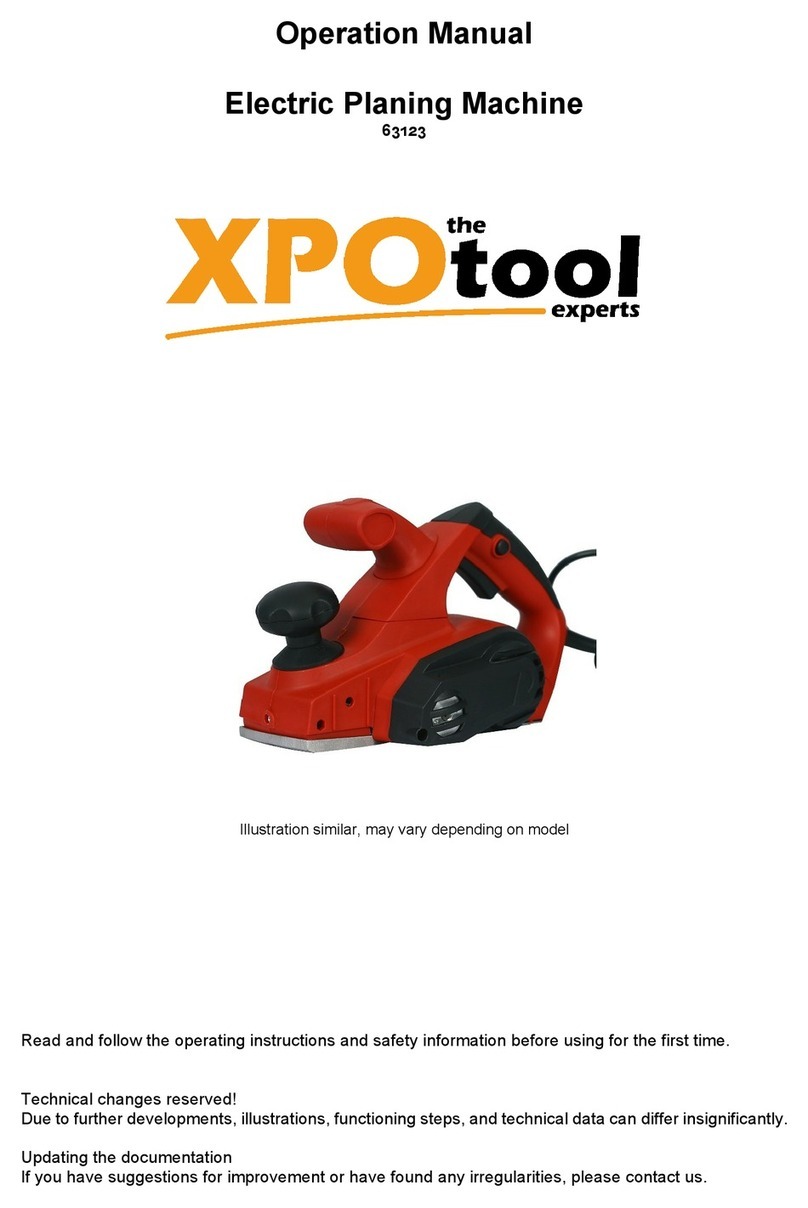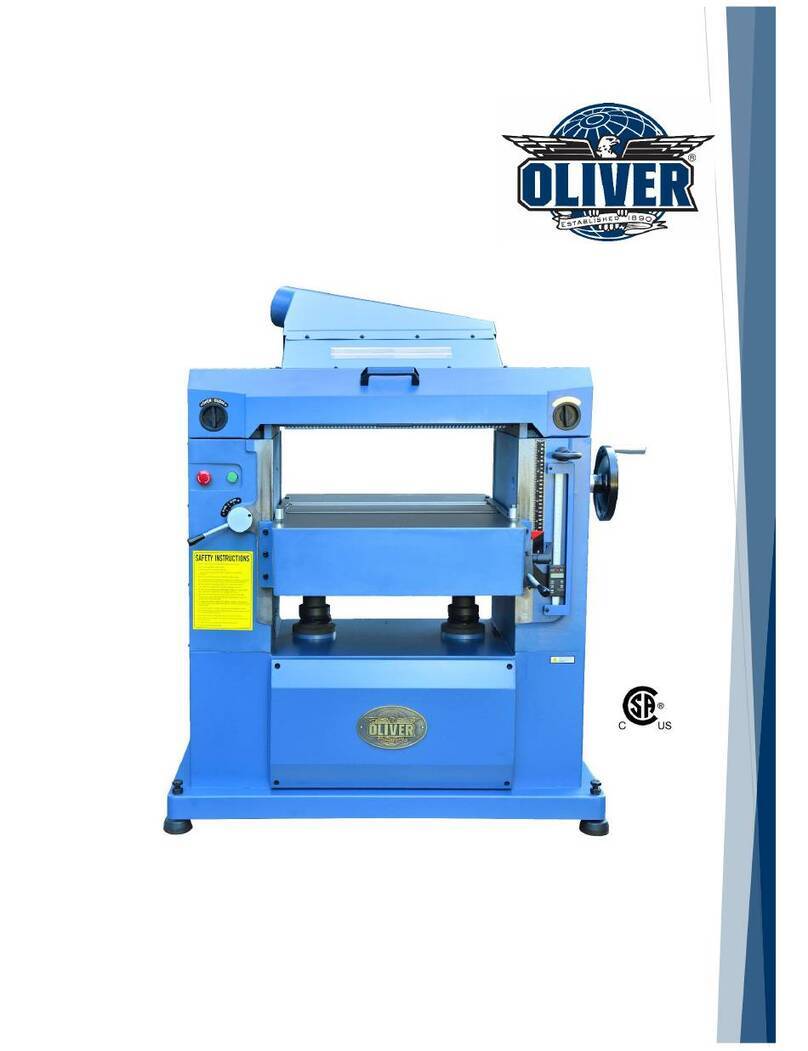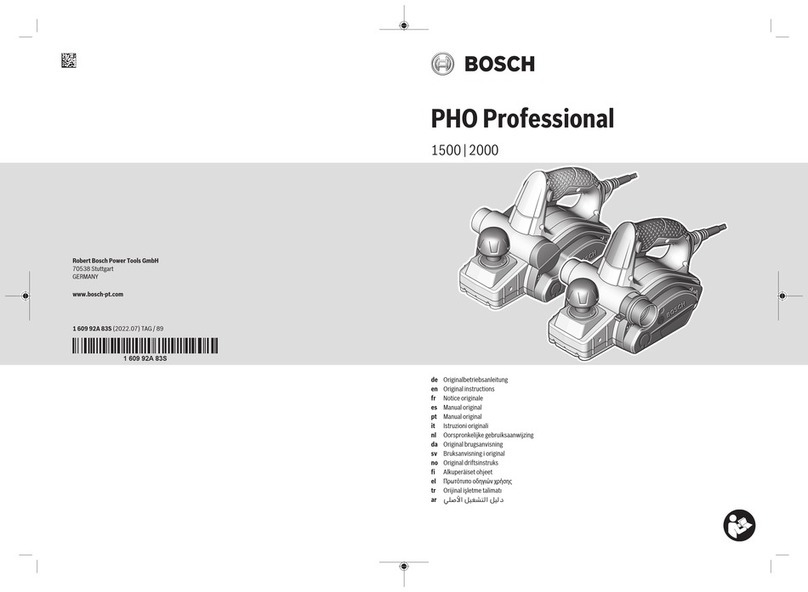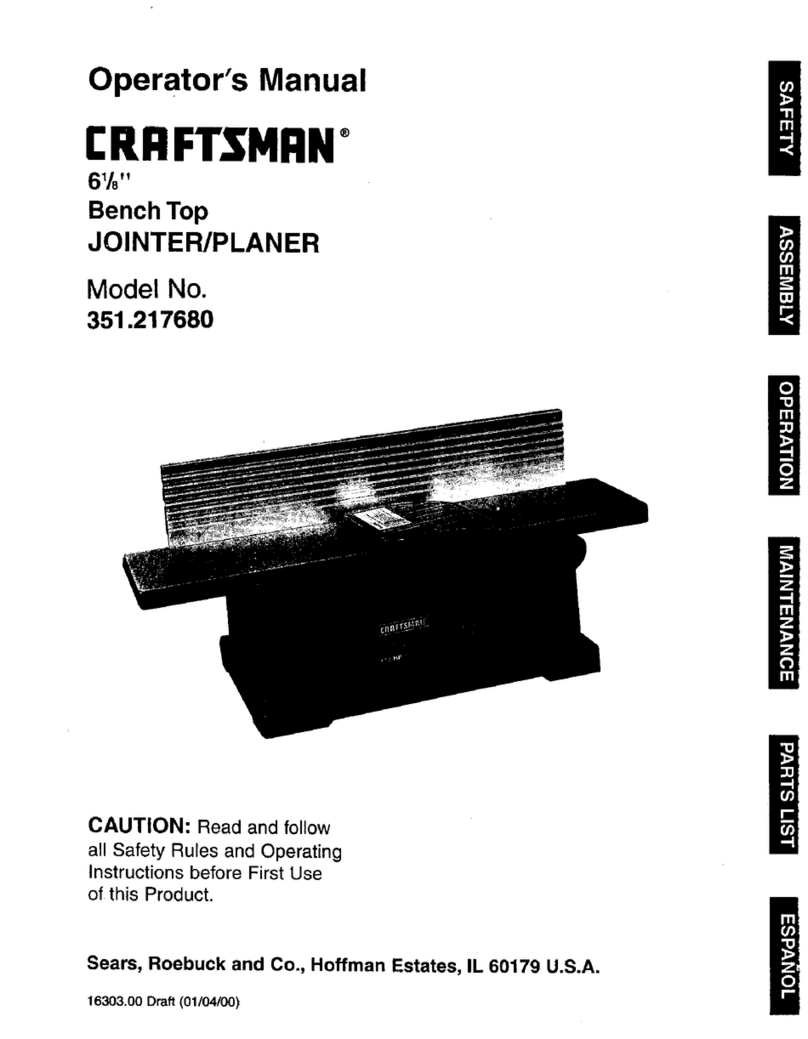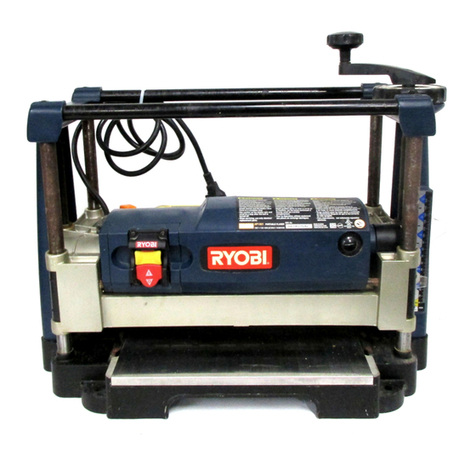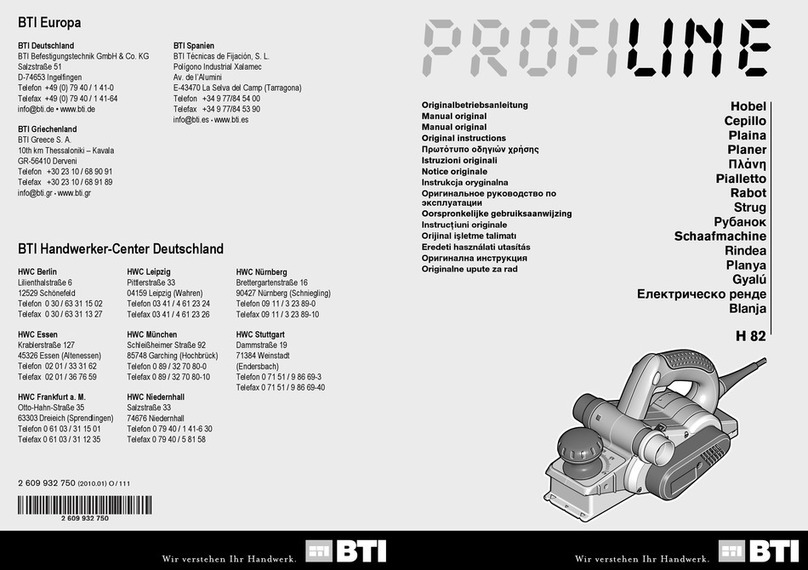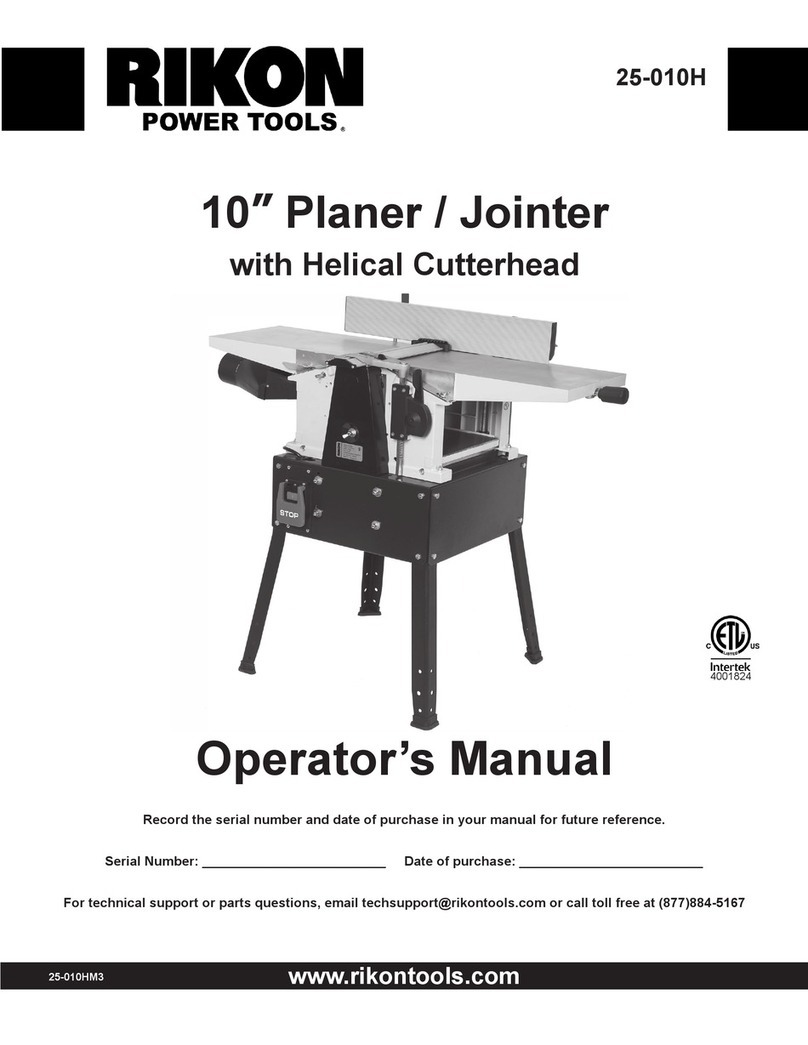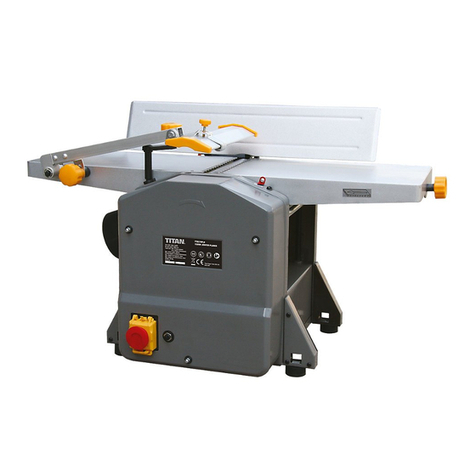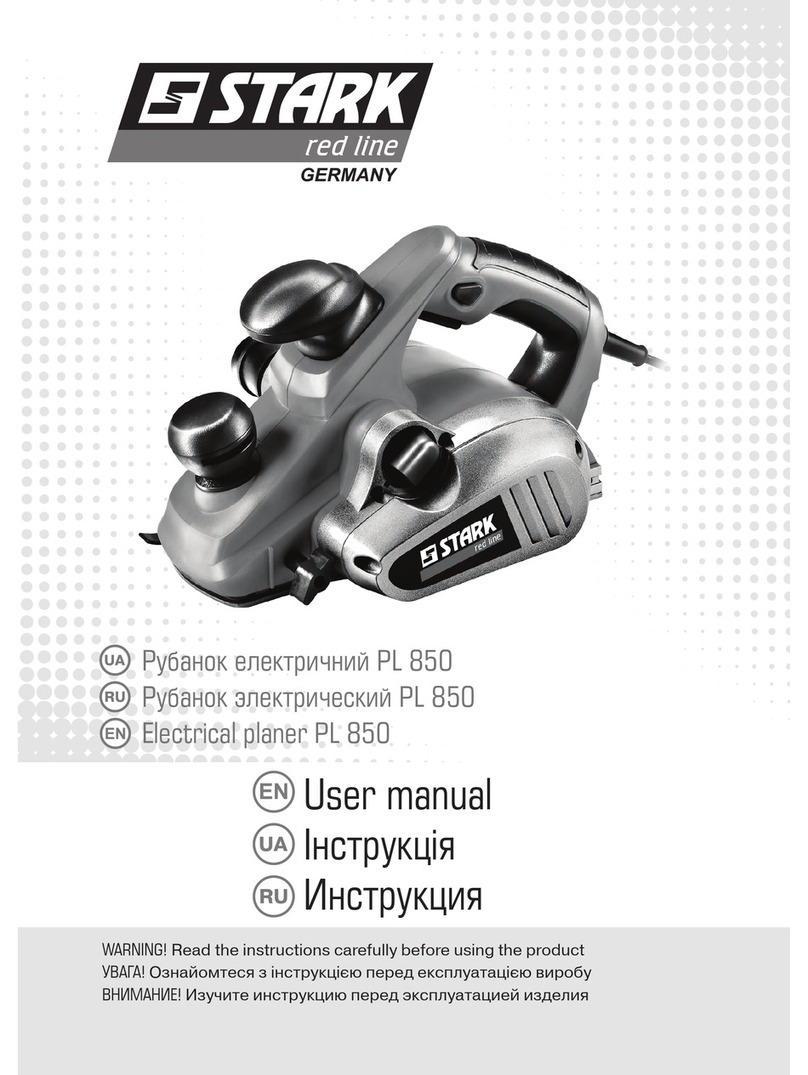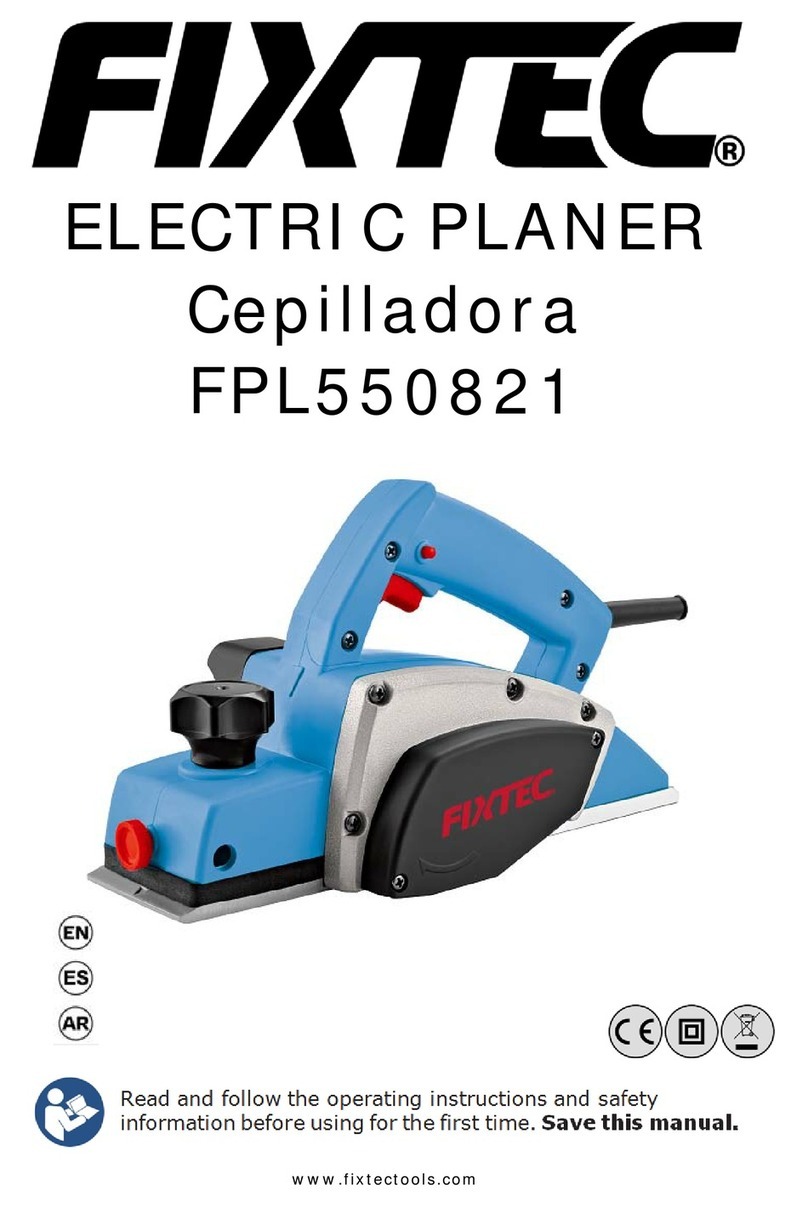Delta TP305 User manual

12½"Portable
Planer
Raboteuse
portativede
317mm(12½po)
Acepilladora
Port_til
12½"pulgadas
A15104-01-13-06Copyright©
2006DeltaMachinery
InstructionManual
Manueld'Utilisation
ManualdeInstrucciones
WWW.DELTAMACHINERY.COM
(800)223-7278-US
(800)463-3582-CANADA

IMPORTANT SAFETY INSTRUCTIONS ........................................................... 2
SAFETY GUIDELINES - DEFINITIONS ........................................................... 3
ADDITIONAL SPECIFIC SAFETY RULES ......................................................... 5
FUNCTIONAL DESCRIPTION .................................................................. 7
CARTON CONTENTS ......................................................................... 7
ASSEMBLY ................................................................................. 8
OPERATION ................................................................................ 9
TROUBLESHOOTING ........................................................................ 14
MAINTENANCE ............................................................................. 14
SERVICE .................................................................................. 16
ACCESSORIES ............................................................................. 16
WARRANTY ................................................................................ 16
FRAN(_AIS ................................................................................. 17
ESPAI_IOL.................................................................................. 33
Read and understand all warnings and operating instructions before using any tool A
_. When using tools or equipment, basic safety precautions should always be followed _
to reduce the risk of personal injury. Improper operation, maintenance or modification of tools or
equipment could result in serious injury and property damage. There are certain applications for which
tools and equipment are designed. Delta Machinery strongly recommends that this product NOT be modified
and/or used for any application other than for which it was designed.
If you have any questions relative to its application DO NOT use the product until you have written Delta Machinery
and we have advised you.
Online contact form at www.deltamachinery.com
Postal Mail: Technical Service Manager
Delta Machinery
4825 Highway 45 North
Jackson, TN 38305
(IN CANADA: 125 Mural St. Suite 300, Richmond Hill, ON, L4B 1M4)
Information regarding the safe and proper operation of this tool isavailable from the following sources:
Power Tool Institute
1300 Sumner Avenue, Cleveland, OH 44115-2851
www.powertoolinstitute.org
National Safety Council
1121 Spring Lake Drive, Itasca, IL 60143-3201
American National Standards Institute, 25 West 43rd Street, 4 floor, New York, NY 10036 www.ansi.org
ANSI 01.1Safety Requirements for Woodworking Machines, and the U.S. Department of Labor regulations www.osha.gov
SAVE THESE INSTRUCTIONS!

it is importantfor youto readandunderstandthis manual.Theinformationit containsrelatesto
protectingYOURSAFETYandPREVENTINGPROBLEMS.Thesymbolsbelowareusedto helpyou _:_
recognize this information.
Indicates an imminently hazardous situation which, if not avoided, will result in death or
-- serious injury.
Indicates a potentially hazardous situation which, if not avoided, could result in death or serious
-- injury.
Indicates a potentially hazardous situation which, if not avoided, may result in minor or moderate
-- injury.
Used without the safety alert symbol indicates potentially hazardous situation which, if not
-- avoided, may result in property damage.
CALIFORNIA PROPOSITION 65
Some dust created by power sanding, sawing, grinding, drilling, and other construction activities
contains chemicals known to cause cancer, birth defects or other reproductive harm. Some examples of these
chemicals are:
• lead from lead-based paints,
• crystalline silica from bricks and cement and other masonry products, and
• arsenic and chromium from chemically-treated lumber.
Your risk from these exposures varies, depending on how often you do this type of work. To reduce your
exposure to these chemicals: work in a well ventilated area, and work with approved safety equipment, always
wear NIOSH/OSHA approved, properly fitting face mask or respirator when using such tools.

Failuretofollowtheserulesmayresultinseriouspersonalinjury.
1. FOR YOUR OWN SAFETY, READ THE INSTRUCTION
MANUAL BEFORE OPERATING THE MACHINE.
Learning the machine's application, limitations, and
specific hazards will greatly minimize the possibility of
accidents and injury.
2. WEAR EYE AND HEARING PROTECTION. ALWAYS
USE SAFETY GLASSES. Everyday eyeglasses are NOT
safety glasses. USE CERTIFIED SAFETY EQUIPMENT.
Eye protection equipment should comply with ANSI
Z87.1 standards. Hearing equipment should comply
with ANSI $3.19 standards.
3. WEAR PROPER APPAREL. Do not wear loose
clothing, gloves, neckties, rings, bracelets, or other
jewelry which may get caught in moving parts. Nonslip
protective footwear is recommended. Wear protective
hair covering to contain long hair.
4. DO NOT USE THE MACHINE IN A DANGEROUS
ENVIRONMENT. The use of power tools in damp or wet
locations or in rain can cause shock or electrocution.
Keep your work area well-lit to prevent tripping or
placing arms, hands, and fingers in danger.
5. MAINTAIN ALL TOOLS AND MACHINES IN PEAK
CONDITION. Keep tools sharp and clean for best and safest
performance. Follow instructions for lubricating and changing
accessories. Poorly maintained tools and machines can
further damage the tool or machine and/or cause injury.
6. CHECK FOR DAMAGED PARTS. Before using the
machine, check for any damaged parts. Check for
alignment of moving parts, binding of moving parts,
breakage of parts, and any other conditions that may
affect its operation. A guard or any other part that is
damaged should be properly repaired or replaced
with Delta or factory authorized replacement parts.
Damaged parts can cause further damage to the
machine and/or injury.
7. KEEP THE WORK AREA CLEAN. Cluttered areas and
benches invite accidents.
8.
9.
KEEP CHILDREN AND VISITORS AWAY. Your shop is a
potentially dangerous environment. Children and visitors can
be injured.
REDUCE THE RISK OF UNINTENTIONAL STARTING.
Make sure that the switch is in the "OFF" position
before plugging in the power cord. In the event of a
power failure, move the switch to the "OFF" position.
An accidental start-up can cause injury. Do not touch
the plug's metal prongs when unplugging or plugging in
the cord.
10. USE THE GUARDS. Check to see that all guards are in
place, secured, and working correctly to prevent injury.
11. REMOVE ADJUSTING KEYS AND WRENCHES
BEFORE STARTING THE MACHINE. Tools, scrap
pieces, and other debris can be thrown at high speed,
causing injury.
12. USE THE RIGHT MACHINE. Don't force a machine
or an attachment to do a job for which it was not
designed. Damage to the machine and/or injury may
result.
13. USE RECOMMENDED ACCESSORIES. The use of
accessories and attachments not recommended by
Delta may cause damage to the machine or injury to
the user.
14. USE THE PROPER EXTENSION CORD. Make sure
your extension cord is in good condition. When using
an extension cord, be sure to use one heaW enough to
carry the current your product will draw. An undersized
cord will cause a drop in line voltage, resulting in loss
of power and overheating. See the Extension Cord
Chart for the correct size depending on the cord length
and nameplate ampere rating. If in doubt, use the next
heavier gauge. The smaller the gauge number, the
heavier the cord.
15. SECURE THE WORKPIECE. Use clamps or a vise to
hold the workpiece when practical. Loss of control of a
workpiece can cause injury.
16. FEED THE WORKPIECE AGAINST THE DIRECTION OF
THE ROTATION OF THE BLADE, CU'R'ER, OR ABRASIVE
SURFACE. Feeding it from the other direction will cause
the workpiece to be thrown out at high speed.
17. DON'T FORCE THE WORKPIECE ON THE MACHINE.
Damage to the machine and/or injury may result.
18. DON'T OVERREACH. Loss of balance can make you
fall into a working machine, causing injury.
19. NEVER STAND ON THE MACHINE. Injury could occur if
the tool tips, or if you accidentally contact the cutting tool.
20. NEVER LEAVE THE MACHINE RUNNING UNA'R'ENDED.
TURN THE POWER OFE Don't leave the machine until it
comes to a complete stop. A child or visitor could be injured.
21. TURN THE MACHINE "OFF", AND DISCONNECT
THE MACHINE FROM THE POWER SOURCE before
installing or removing accessories, changing cutters,
adjusting or changing sat-ups. When making repairs,
be sure to lock the start switch in the "OFF" position.
An accidental start-up can cause injury.
22. MAKE YOUR WORKSHOP CHILDPROOF WITH
PADLOCKS, MASTER SWITCHES, OR BY
REMOVING STARTER KEYS. The accidental start-up
of a machine by a child or visitor could cause injury.
23. STAY ALERT, WATCH WHAT YOU ARE DOING,
AND USE COMMON SENSE. DO NOT USE THE
MACHINE WHEN YOU ARE TIRED OR UNDER
THE INFLUENCE OF DRUGS, ALCOHOL, OR
MEDICATION. A moment of inattention while operating
power tools may result in injury.
24. _ USE OF THIS TOOL CAN
GENERATE AND DISBURSE DUST OR OTHER
AIRBORNE PARTICLES, INCLUDING WOOD DUST,
CRYSTALLINE SILICA DUST AND ASBESTOS DUST.
Direct particles away from face and body. Always
operate tool in well ventilated area and provide for
proper dust removal. Use dust collection system
wherever possible. Exposure to the dust may cause
serious and permanent respiratory or other injury,
including silicosis (a serious lung disease), cancer, and
death. Avoid breathing the dust, and avoid prolonged
contact with dust. Allowing dust to get into your mouth
or eyes, or lay on your skin may promote absorption of
harmful material. Always use properly fitting NIOSH/
OSHA approved respiratory protection appropriate for
the dust exposure, and wash exposed areas with soap
and water.

Failure to follow these rules may result in serious personal injury.
1. DO NOT OPERATE THIS MACHINE until it is
completely assembled and installed according to the
instructions. A machine incorrectly assembled can
cause serious injury.
2. OBTAIN ADVICE from your supervisor, instructor,
or another qualified person if you are not thoroughly
familiar with the operation of this machine.
Knowledge is safety.
3. FOLLOW ALL WIRING CODES and recommend-
ed electrical connections to prevent shock or
electrocution.
4. KEEP KNIVES SHARP and free from rust and pitch.
Dull or rusted knives work harder and can cause
kickback.
5. NEVER TURN THE MACHINE "ON" before clearing
the table of all objects (tools, scraps of wood, etc.).
Flying debris can cause serious injury.
6. NEVER TURN THE MACHINE "ON" with the work-
piece contacting the cutterhead. Kickback can
occur.
7. SECURE THE MACHINE TO A SUPPORTING SUR-
FACE to prevent the machine from sliding, walking
or tipping over.
8. PROPERLY SECURE THE KNIVES IN THE CUTTER-
HEAD before turning the power "ON". Loose blades
may be thrown out at high speeds causing serious
injury.
9. LOCK THE SPEED SETTING SECURELY before
feeding the workpiece through the machine.
Changing speeds while planing can cause kick-
back.
10. AVOID AWKWARD OPERATIONS AND HAND POSI-
TIONS. A sudden slip could cause a hand to move
into the knives.
11. KEEP ARMS, HANDS, AND FINGERS away from
the cutterhead, the chip exhaust opening, and the
feed rollers to prevent severe cuts.
12. NEVER REACH INTO THE CUTTERHEAD AREA
while the machine is running. Your hands can be
drawn into the knives.
13. DO NOT STAND IN LINE OF THE WORKPIECE.
Kickback can cause injury.
14. ALLOW THE CUTTERHEAD TO REACH FULL SPEED
before feeding a workpiece. Changing speeds while
planing can cause kickback.
15. WHEN PLANING BOWED STOCK, place the concave
(cup down) side of the stock on the table and cut
with the grain to prevent kickback.
16. DO NOT FEED A WORKPIECE that iswarped, contains
knots, or is embedded with foreign objects (nails,
staples, etc.). Kickback can occur.
17. DO NOT FEED A SHORT, THIN, OR NARROW
WORKPIECE INTO THE MACHINE. Your hands can
be drawn into the knives and/or the workpiece can
be thrown at high speeds. See the "OPERATION"
section of this instruction manual for details.
18. DO NOT FEED A WORKPIECE into the outfeed end of
the machine. The workpiece will be thrown out of the
opposite side at high speeds.
19. REMOVE SHAVINGS ONLY with the power "OFF" to
prevent serious injury.
20. PROPERLY SUPPORT LONG OR WIDE WORK-
PIECES. Loss of control of the workpiece can cause
serious injury.
21. NEVER PERFORM LAYOUT, ASSEMBLY or set-up
work on the table/work area when the machine is
running. Serious injury will result.
22. TURN THE MACHINE "OFF", DISCONNECT IT FROM
THE POWER SOURCE, and clean the table/work area
before leaving the machine. LOCK THE SWITCH IN
THE "OFF" POSITION to prevent un-authorized use.
Someone else might accidentally start the machine
and cause injury to themselves or others.
23. ADDITIONAL INFORMATION regarding the safe
and proper operation of power tools (i.e. a safety
video) is available from the Power Tool Institute, 1300
Sumner Avenue, Cleveland, OH 44115-2851 (www.
powertoolinstitute.com). Information is also available
from the National Safety Council, 1121 Spring Lake
Drive, Itasca, IL 60143-3201. Please refer to the
American National Standards Institute ANSI 01.1
Safety Requirements for Woodworking Machines
and the U.S. Department of Labor Regulations.
SAVE THESE INSTRUCTIONS.
Refer to them often and use them to instruct others.

POWER CONNECTIONS
A separate electrical circuit should be used for your machines. This circuit should not be less than #12 wire and should
be protected with a 20 Amp time lag fuse. If an extension cord is used, use only 3-wire extension cords which have
3-prong grounding type plugs and matching receptacle which will accept the machine's plug. Before connecting the
machine to the power line, make sure the switch (s) is in the "OFF" position and be sure that the electric current is of
the same characteristics as indicated on the machine. All line connections should make good contact. Running on low
voltage will damage the machine.
Do not expose the machine to rain or operate the machine in damp locations.
MOTOR SPECIFICATIONS
Your machine is wired for 120V, 60 HZ alternating current. Before connecting the machine to the power source, make
sure the switch is in the "OFF" position.
GROUNDING INSTRUCTIONS
This machine must be grounded while in use to protect the operator from electric shock.
1. All grounded, cord-connected machines:
In the event of a malfunction or breakdown, grounding provides a path of least resistance for electric current to
reduce the risk of electric shock. This machine is equipped with an electric cord having an equipment-grounding
conductor and a grounding plug. The plug must be plugged into a matching outlet that is properly installed and
grounded in accordance with all local codes and ordinances.
Do not modify the plug provided - if it will not fit the outlet, have the proper outlet installed by a qualified electrician.
Improper connection of the equipment-grounding conduc-tor can result in risk of electric shock. The conductor with
insulation having an outer surface that is green with or without yellow stripes is the equipment-grounding conductor.
If repair or replacement of the electric cord or plug is necessary, do not connect the equipment-grounding conductor
to a live terminal.
.
Check with a qualified electrician or service personnel if the grounding instructions are not completely understood, or
if in doubt as to whether the machine is properly grounded.
Use only 3-wire extension cords that have 3-prong grounding type plugs and matching 3-conductor receptacles that
accept the machine's plug, as shown in Fig. A.
Repair or replace damaged or worn cord immediately.
Grounded, cord-connected machines intended for use on a supply circuit having a nominal rating less
than 150 volts:
If the machine is intended for use on a circuit that has an outlet that looks like the one illustrated in Fig. A, the
machine will have a grounding plug that looks like the plug illustrated in Fig. A. A temporary adapter, which looks like
the adapter illustrated in Fig. B, may be used to connect this plug to a matching 2-conductor receptacle as shown
in Fig. B if a properly grounded outlet is not available. The temporary adapter should be used only until a properly
grounded outlet can be installed by a qualified electrician. The green-colored rigid ear, lug, and the like, extending
from the adapter must be connected to a permanent ground such as a properly grounded outlet box. Whenever the
adapter is used, it must be held in place with a metal screw.
NOTE: In Canada, the use of a temporary adapter is not permitted by the Canadian Electric Code.
In all cases, make certain that the receptacle in question is properly grounded. If you are not sure,
have a qualified electrician check the receptacle.
GROUNDED OUTLET BOX
CURRENT
CARRYING_
IS LONGEST OF THE 3 BLADES
GROUNDED OUTLET BOX
_ADAPTER
Fig. A Fig. B

EXTENSION CORDS
Use proper extension cords. Make
sure your extension cord is in good condition and is a
3-wire extension cord which has a 3-prong grounding
type plug and matching receptacle which will accept
the machine's plug. When using an extension cord,
be sure to use one heavy enough to carry the current
of the machine. An undersized cord will cause a
drop in line voltage, resulting in loss of power and
overheating. Fig. C, shows the correct gauge to use
depending on the cord length. If in doubt, use the
next heavier gauge. The smaller the gauge number,
the heavier the cord.
MINIMUM GAUGE EXTENSION CORD
RECOMMENDED SIZES FOR USE WITH STATIONARY ELECTRIC MACHINES
Total
Length of
Cord in Gauge of Extension
Feet Cord
upto 25 18 AWG
25-50 16 AWG
50-100 16 AWG
100-150 14 AWG
upto 25 18 AWG
25-50 16 AWG
50-100 14 AWG
100-150 12 AWG
upto 25 16 AWG
25-50 16 AWG
50-100 14 AWG
Ampere
Ratin£1 Volts
0-6 120
0-6 120
0-6 120
0-6 120
6-10 120
6-10 120
6-10 120
6-10 120
10-12 120
10-12 120
10-12 120
10-12 120
12-16 120
12-16 120
12-16 120
100-150 12 AWG
upto25 14 AWG
25-50 12 AWG
GREATER THAN 50 FEET NOT RECOMMENDED
Fig. C
FOREWORD
Delta TP305 is a 121/2'' (317mm) Portable Planer. This planer can handle workpieces up to 121/2'' (317mm) wide and 6"
(152mm) thick. The maximum depth of cut is 3/32" (2.4 mm). The TP305 features a powerful 15 amp, 120 volt motor, a
two-knife cutterhead with double-edged reversible knives, knife-installation tool and wrench
NOTICE: The photo on the manual cover illustrates the current production model. All other illustrations contained in the
manual are representative only and may not depict the actual labeling or accessories included. These are intended to
illustrate technique only.
sa....... []
sS
Fq
i
1. Planer
2. Cutterhead Guard
i
'.......... r_
3. Knife Transfer Tool
4. 5mm Wrench Assembly
5. M5 x 20mm Hex Socket Head Screw
6. M5xl0mm Knob (2)
7. Elevating Handle

UNPACKING AND CLEANING
Carefully unpack the machine and all loose items from the shipping container(s). Remove the rust-preventative oil from
using a soft cloth moistened with mineral spirits, paint thinner or denatured alcohol.
Do not use highlyvolatile solvents such as gasoline, naphtha, acetone or lacquer thinner for cleaning your
machine.
After cleaning, cover the unpainted surfaces with a good quality household floor paste wax.
For your own safety, do not connect the machine to the power source until the machine is
completely assembled and you read and understand the entire instruction manual.
ASSEMBLY TOOLS REQUIRED
5mm wrench (included)
ASSEMBLY TIME ESTIMATE
Assembly for this machine takes approximately 30 minutes.
RAISING AND LOWERING HANDLE
Attach the raising and lowering handle (A) Fig. 4 to the shaft (B) and fasten in place with M5x20mm screw (C). NOTE:
Ensure that the flats of the handle and the flats on the shaft are aligned. Flip handle (A) upward as shown in Fig. 5.
LOWERING EXTENSION TABLES
The infeed and outfeed extension tables (A) Fig.
6 are shipped attached to the machine in the raised
position. Lower the tables (A) on both sides of the planer
(Fig. 6). The top surface of extension tables should be
level with the planer table. To check and adjust, refer to
the section "LEVELING EXTENSION TABLES" in this
manual.

CUTTERHEAD GUARD
1. Attach the cutterhead guard (A) Fig. 7 to the planer
by inserting the end of the guard over the top of the
cutterhead. Place the slots in the cutterhead guard (C)
over the tapped holes (B).
2. Fasten cutterhead guard (A) Fig. 8 to planer using two
knobs, one of which is shown at (D).
Make sure that the cutterhead guard is
properly secured with the knobs before operating this
machine.
FASTENING PLANER TO SUPPORTING
SURFACE
During operation, if there is any tendency for the planer to
tip over, slide or "walk" across the supporting surface, the
planer must be secured to the supporting surface. Four
holes (two of which are shown at (A) Fig. 9 are provided
for this purpose.
IOPERATIONAL CONTROLS AND ADJUSTMENTS
STARTING AND STOPPING PLANER
Make sure that the switch is in the
"OFF" position before plugging cord into outlet, Do
not touch the plug's metal prongs when unplugging or
plugging in the cord,
1. The on/off switch (A) Fig. 10 is located on the front
of the planer moter. To turn the machine "ON", move
the switch up to the "ON" position.
2. Toturn the machine "OFF", move the switch (A) down
to the "OFF" position.
I

LOCKING SWITCH IN THE "OFF" POSITION
IMPORTANT: When the machine is not in use, the
switch should be locked in the "OFF" position to
prevent unauthorized use. To lock the machine, grasp
the switch toggle (D)and pull it out of the switch (Fig. 11).
With the switch toggle (D) removed, the switch will not
operate. However, should the switch toggle be removed
while the planer is running, the machine can be turned
"OFF," but cannot be restarted without reinserting the
switch toggle (D).
In the event of a power outage (such
as a breaker or fuse trip), always move the switch to
the "OFF" position until the main power is restored.
RAISING AND LOWERING HEAD ASSEMBLY
The head assembly (A) Fig. 12A contains the cutterhead
feed rollers, cutterhead guard and motor. Raising and
lowering the head assembly controls the depth-of-cut on
your planer. To raise or lower the head assembly, rotate
the handle (D).
NOTE: One revolution of the handle will move the
cutterhead up or down approximately 5/64" (2 mm).
An English/metric scale and pointer (C) is located on the
front of the planer to indicate the height of the cutterhead.
Adjustment to the pointer can be made by running a piece
of wood through the machine. Measure the thickness of
the workpiece and if an adjustment is necessary, loosen
two screws (B) and adjust pointer accordingly. Then
tighten two screws.
Refer to Fig. 12B for recommended maximum depth-of-
cut for various board widths of soft and hard woods.
Continuous operation at the deepest
depth of cut can cause premature motor failure.
Fig. 12A
Fig. 12B I
Board Width
2" (50.8 mm)
4" (101.6 mm)
6" (152.4 mm)
7, (177:8 mm)
Maximum depth-of-cut
Soft Woods
3/32" (2.4 mm)
3/32" (2.4 mm)
3/32" (2.4 mm)
3/32" (2.4 mm)
8" (20312 mm) 3/32" (2.4 mm)
g" (228.6 mm)5/64" (2 mm)
10" (254 mm)1/16" (1.6 mm)
11" (279.4 mm) 1/16" (1.6 mm)
12" (304.8 mm) 1/16" (1.6 mm)
Hard Woods
3.32" (2.4 mm)
3/32" (2.4 mm)
3/32" (2.4 mm)
3/32" (2.4 mm)
3/32" (2.4 mm)
1/16" (1.5 mm)
3/64" (1.2 mm)
3/64" (1.2 mm)
3/64" (1.2 mm)
10

LEVELING EXTENSION TABLES
The extension tables (A) and (G) Fig. 14 must be level
with the planer table. To check the extension tables and
adjust if necessary:
1. Place a straight edge (B) Fig. 14 on the planer table
(E) with one end extending out over the infeed table
(A). Check to see if the infeed table is level with the
planer table on both ends of the planer table.
2. If an adjustment is necessary, loosen the Iocknut (C)
Fig. 14, and adjust the stop screw (D) on each side
of the infeed table (A) until the extension table is
level with the planer table (E). Tighten the Iocknut
(C). Recheck and make certain that the inside edge
of table extension is level with the planer table.
If necessary, loosen the two screws (F), adjust
the extension table and retighten the two screws
(F).Adjust the opposite side of the table in the same
manner. Make certain that the extension table is
solidly supported when downward pressure on the
table is applied.
3. Check and adjust the outfeed table (G) in the same
maDDer.
KNIFE TRANSFER TOOL STORAGE
The knife transfer tool (A) Fig. 15, supplied with your
planer, can easily be stored underneath the outfeed table
extension (B) when not being used. A Velcro strip (C) is
provided on the tool and underneath the table for this
purpose.
WRENCH STORAGE
The wrench (A) Fig. 16, can be stored in hole (B) located
on the right rear side of the machine as shown. ÷÷
11

CARRYING HANDLE/STOCK
TRANSFER BAR
1. Your planer is provided with a foam covered carrying
handle (A) Fig. 17, located on top of the machine, for
ease in transporting the planer.
,The carrying handle (A) Fig. 18, also doubles as a
stock transfer bar for transferring stock from the
outfeed to infeed end of the machine. This is helpful
when planing long material, as the workpiece can
easily be transferred back to the infeed end of the
machine for additional cuts.
REPLACING KNIVES
The knives supplied with your planer are double edged
and reversible, which enables you to turn the knives
end-for-end when one edge becomes dull or chipped. To
change the knives, proceed as follows:
Disconnect tool from power source.
1. Raise head assembly all the way to the top.
2. Remove cutterhead guard (B) Fig. 19 by removing
two knobs, one of which is shown at (A).
The knives are sharp. Be careful when
removing, handling or installing knives.
3. Using the supplied wrench (E) Fig. 20, unscrew the
six screws at (F), only enough until locking bar (D)
separates from knife, allowing knife to be removed.
12

.Insert knife transfer tool (G) Fig. 21, underneath
center of knife. Lift the knife transfer tool up until
knife (H) separates from pins (J) and pull out and
remove knife as shown. NOTE: Knife transfer tool is
magnetized, allowing it to attach to knife.
5. Rotate knife (H) Fig. 22 end-for-end, or using a new
knife, position knife transfer tool (G) on top of knife
as shown. Place knife in cutterhead with bevel up
underneath locking bar (D), making sure pins (J) in
cutterhead engage with holes (K) in knife.
6. Remove knife transfer tool and tighten the six screws
at (F)Fig. 23, using wrench (E)supplied.
7. Replace other knife by rotating head 180 degrees and
repeat STEPS 3 THROUGH 6.
8. Slide cutterhead guard (B) Fig. 25 in as far as possible
and replace two knobs, one of which is shown at
(A) Fig. 25. These knobs were removed in STEP 2.
13

I MACHINE USE I
When using your machine, follow these few simple steps
for achieving the best results.
1. True Up One Face - Feed one face of the board
over a jointer, making thin cuts with each pass, until
the entire surface is flat.
2. Plane to Thickness - Place the side you planed in
STEP 1 face down and feed the board through the
planer, (Fig. 26). Plane until this side is flat, then plane
both sides of the board until you are satisfied with
the thickness. Make thin cuts, and alternate sides
with each pass. If, during the planing operation, you
notice the board twisting, warping, or bowing, repeat
STEP 1 and true up one face.
3. When planing long stock, provide table extensions
to support the infeed and outfeed end of the
workpiece.
4. Plane with the grain only, and keep planer table
clean. Occasionally, wax the table surface to reduce
friction during the planing operation.
5. Cross-cut to Final Length - Cross-cut lumber to
final length.
The knives on the planer will not wear
evenly if the wood is fed through the same spot on
the table every time. Feed the wood through the
planer at different spots on the table to help eliminate
uneven wear of the knives.
For assistance with your machine, visit our website at www.deltamachinery.com for a list of service centers or call the
DELTA Machinery help line at 1-800-223-7278 (In Canada call 1-800-463-3582).
KEEP MACHINE CLEAN
Periodically blow out all air passages with dry compressed
air. All plastic parts should be cleaned with a soft damp
cloth. NEVER use solvents to clean plastic parts. They
could possibly dissolve or otherwise damage the material.
Wear certified safety equipment for
eye, hearing and respiratory protection while using
compressed air.
FAILURE TO START
Should your machine fail to start, check to make sure
the prongs on the cord plug are making good contact
in the outlet. Also, check for blown fuses or open circuit
breakers in the line.
LUBRICATION & RUST PROTECTION
Apply household floor paste wax to the machine table,
extension table or other work surface weekly. Or use a
commercially available protective product designed for
this purpose. Follow the manufacturer's instructions for
use and safety.
To clean cast iron tables of rust, you will need the
following materials: a sheet of mediurr_Scotch-Brite TM
Blending Hand Pad, a can of WD-40 and a can of
degreaser. Apply the WD-40 and polish the table surface
with the Scotch-Brite pad. Degrease the table, then apply
the protective product as described above.
14

BRUSH INSPECTION AND
REPLACEMENT
Disconnect tool from power source
Brush life varies. It depends on the load on the motor.
Check the brushes after the first 50 hours of use for a
new machine or after a new set of brushes has been
installed. After the first check, examine them after about
10 hours of use until such time that replacement is
necessary.
The brush holders, one of which is shown at (A) Fig. 27,
are located on the motor housing opposite each other.
One of the brushes, removed for inspection, is illustrated
in Fig. 28. When the carbon (B) on either brush is worn
to 3/16" in length or if either spring (C) or shunt wire is
burned or damaged in any way, replace both brushes.
If the brushes are found serviceable after removing, re-
install them in the same position as removed.
After brush maintenance is
completed, the cutterhead guard must be re-installed
before starting the planer.
LUBRICATION
The gears in the gear box and the feed roller bushings
should be lubricated periodically.
Disconnect tool from power source.
1. Remove the screw (A)Fig. 29, and nut located on the
other end of screw. Remove the side cover (B) from
the left side of the planer.
2. Place a light coat of E.P. multi-purpose grease on
the teeth of the gears (C) Fig. 30, and a light coat
of spray lubricant on the chains (F). Replace the side
cover.
3. Place the planer on its back and squirt oil on the feed
roller bushings (D) Fig. 31 at each end of the feed
rollers (E).
15

REPLACEMENT PARTS
Use only identical replacement parts. For a parts list or to
order parts, visit our website at servicenet.deltamachinery.
com. You can also order parts from your nearest factory-
owned branch, or by calling our Customer Care Center at
1-800-223-7278 to receive personalized support from highly-
trained technicians.
SERVICE AND REPAIRS
All quality tools will eventually require servicing and/or
replacement of parts. For information about Delta Machinery,
its factory-owned branches, or an Authorized Warranty
Service Center, visit our website at www.deltamachinery.
corn or call our Customer Care Center at 1-800-223-7278.
All repairs made by our service centers are fully guaranteed
against defective material and workmanship. We cannot
guarantee repairs made or attempted by others.
You can also write to us for information at Delta Machinery,
4825 Highway 45 North, Jackson, Tennessee 38305 -
Attention: Product Service. Be sure to include all of the
information shown on the nameplate of your tool (model
number, type, serial number, etc.)
A complete line of accessories is available from your Delta Supplier, Porter-Cable • Delta Factory Service Centers, and
Delta Authorized Service Stations. Please visit our Web Site www.deltamachinery.com for a catalog or for the name of
your nearest supplier.
Since accessories other than those offered by Delta have not been tested with this product, use
of such accessories could be hazardous. For safest operation, only Delta recommended accessories should be
used with this product.
To register your tool for warranty service visit our website at www.deltamachinery.com.
Two Year Limited New Product Warranty
Delta will repair or replace, at its expense and at its option, any new Delta machine, machine part, or machine accessory which in normal
use has proven to be defective in workmanship or material, provided that the customer returns the product prepaid to a Delta factory service
center or authorized service station with proof of purchase of the product within two years and provides Delta with reasonable opportunity
to verify the alleged defect by inspection. For all refurbished Delta product, the warranty period is 180 days. Delta may require that electric
motors be returned prepaid to a motor manufacturer's authorized station for inspection and repair or replacement. Delta will not be responsible
for any asserted defect which has resulted from normal wear, misuse, abuse or repair or alteration made or specifically authorized by anyone
other than an authorized Delta service facility or representative. Under no circumstances will Delta be liable for incidental or consequential
damages resulting from defective products. This warranty is Delta's sole warranty and sets forth the customer's exclusive remedy, with respect
to defective products; all other warranties, express or implied, whether of merchantability, fitness for purpose, or otherwise, are expressly
disclaimed by Delta.
16

FRAN(_AIS

Lire et comprendre toutes instructions d'avertissements et operation avant A
d'utiliser n'importe quel outil ou n'importe quel equipement. En utilisant les outils ou I'equipement, les _
precautions de sQret6 fondamentales toujours devraient 6tre suivies pour reduire le risque de blessure
personnelle. L'operation d6plac6e, I'entretien ou la modification d'outils ou d'equipement ont pour resultat
la blessure serieux et les dommages de propri6t& II y a de certaines applications pour lequel outils et I'equipement
sont con_us. La Delta Machinery recommande avec force que ce produit n'ait pas modifie et/ou utilise pour
I'application autrement que pour lequel il a 6t6 con_u.
Si vous avez n'importe quelles questions relatives & son application n'utilisent pas le produit jusqu'& ce que vous avez ecrit
Delta Machinery et nous vous avons conseill&
La forme en ligne de contact & www.deltamachinery.com
Courrier Postal: Technical Service Manager
Delta Machinery
4825 Highway 45 North
Jackson, TN 38305
Information en ce qui concerne I'operation sore et correcte de cet outil est disponible des sources suivantes:
Power Tool Institute
1300 Sumner Avenue, Cleveland, OH 44115-2851
www.powertoolinstitute.org
National Safety Council
1121 Spring Lake Drive, Itasca, IL 60143-3201
American National Standards Institute, 25 West 43rd Street, 4 floor, New York, NY 10036 www.ansi.org ANSI 01.1 Safety
Requirements for Woodworking Machines, and the U.S. Department of Labor regulations www.osha.gov
Ce guide contient des renseignements importants que vous deviez bien saisir. Cette information porte sur VOTRE _z_
SECURITE et sur LA PREVENTION DE PROBLEMES D'IeQUlPEMENT. Afin de vous aider & identifier cette
information, nous avons utilis6 les symboles ci-dessous. Veuillez lire attentivement ce guide en portant une attention
particuliere & ces sections.
Indique un danger imminent qui, s'il n'est pas 6vit6, causera de graves blessures ou la mort.
Indique la possibilit6 d'un danger qui, s'il n'est pas evit6, pourrait causer de graves blessures
ou la mort.
Indique la possibilit6 d'un danger qui, s'il n'est pas evit6, peut causer des dommages &la propri6t&
Sans le symbole d'alerte.lndique la possibilit6 d'un danger qui, s'il n'est pas 6vit6, peut causer des
dommages; mineures ou moyennes.
LA PROPOSITION DE CALIFORNIE 65
La poussiere produite par le pon£age electrique le sciage, le meulage, le per£age et autres
activites de construction peut contenir des produits chimiques qui sont reconnus, par I'etat de la Californie, de causer
le cancer, les anomalies cong6nitales ou autres maux de reproduction. Ces produits chimiques comprennent, entre
autres :
• le plomb provenant des peintures & base de plomb;
• la silice cristalline provenant de briques, de b6ton ou d'autres produits de magonnerie
• I'arsenic et le chrome provenant du bois de charpente trait6 chimiquement
Le risque d'exposition & ces produits depend de la frequence d'ex6cution de ce genre de travaux. Afin de reduire I'exposition
& ces produits chimiques, travaillez dans un endroit bien aer6 et utilisez de I'equipement de securit6 approuve, portez toujours
un masque facial ou respirateur homologu6 MSHA/NIOSH bien ajuste Iorsque vous utilisez de tels outils.
CONSERVEZ CES INSTRUCTIONS!
18

_Negliger de suivre ces r6gles risque d'entrainer des blessures graves.
1 POUR SA SI_CURIT¢ PERSONNELLE, LIRE LA NOTICE
D'UTILISATION, AVANT DE METTRE LA MACHINE EN
MARCHE, et pour aussi apprendre I'application et les limites
de la machine ainsi que les risques qui lui sont particuliers ainsi,
les possibilites d'accident et de blessures seront beaucoup
reduites.
2. PORTEZ DES DISPOSITIFS DE PROTECTION DES YEUX
ET DE L'OU'IE. UTILISEZ TOUJOURS DES LUNETTES DE
S¢CURITE. Des lunettes ordinaires ne constituent PAS des
lunettes de securit& UTILISEZ DES EQUlPEMENTS DE
SORET¢ HOMOLOGUES. Les dispositifs de protection des
yeux doivent _tre conformes aux normes ANSI Z87.1. Les
dispositifs de protection de I'oufe doivent 6tre conformes aux
normes ANSI $3.19.
3. PORTER UNE TENUE APPROPRIEE. Pas de cravates, de
gants, ni de v6tements amples. Enlever montre, bagues et
autres bijoux. Rouler les manches. Les v6tements ou les bijoux
qui se trouvent pris dans les pi6ces mobiles peuvent entrainer
des blessures.
4. NE PAS UTILISER LA MACHINE DANS UN
ENVlRONNEMENT DANGEREUX. L'utilisation d'outils
electriques darts des endroits humides ou sous la pluie peut
entrainer des decharges electriques ou une electrocution.
Carder la zone de travail bien eclair6e pour eviter de trebucher
ou d'exposer les doigts, les mains ou les bras & une situation
dangereuse.
5. CARDER LES OUTILS ET LES MACHINES EN PARFAIT
ETAT. Garder les outils affQtes et propres afin d'obtenir le
meilleur et le plus sot rendement. Suivre les instructions pour
lubrifier et changer les accessoires. Les outils et les machines
mal entretenus peuvent se degrader davantage, et/ou entrainer
des blessures.
6. INSPECTER LES PIECES POUR D¢CELER TOUT
DOMMAGE. Avant d'utiliser la machine, la v6rifier pour voir s'il
n'y a pas de pieces endommagees. V@ifier I'alignement des
pi6ces mobiles et si ces pi6ces ne se coincent pas, la rupture
de pieces, ou toute autre condition pouvant en affecter le
fonctionnement. Toute piece ou protecteur endommage doit
6tre repare ou remplac& Les pi_ces endommagees peuvent
degrader davantage la machine et/ou entrafner des blessures.
7. CARDER L'AIRE DE TRAVAIL PROPRE. Les zones et 6tablis
encombres favorisent les accidents.
8. CARDER LES ENFANTS ET LES VISITEURS A DISTANCE.
Uatelier est un lieupotentiellement dangereux. Les enfants et les
visiteurs peuvent se blesser.
9. EVITER LE DCMARRAGE ACCIDENTEL. S'assurer que
I'interrupteur est sur ,<OFF _ (ARRItT) avant de brancher le
cordon. En cas de coupure de courant, placer I'interrupteur
& la position <_OFF _ (ARRI2T).Un demarrage accidentel peut
entrainer des blessures.
10. UTIMSER LES DISPOSITIFS PROTECTEURS. V@ifier que tous
les dispositifs protecteurs sont bien en place, bien fixes et en
bon etat de marche pour eviter les blessures.
11. ENLEVER LES CLES DE RCGLAGE ET CELLES DE SERRAGE
AVANT DE ME'n'RE LA MACHINE EN MARCHE. Les outils,
les chutes et les autres debris peuvent 6tre projetes violemment
et blesser.
12. UTILISER LA BONNE MACHINE. Ne pas forcer la machine ou
I'accessoire & faire un travail pour lequel il n'a pas et6 congu.
Des dommages b,la machine et/ou des blessures pourraient
s'ensuivre.
13. UTILISER LES ACCESSOIRES RECOMMANDI_S. L'utilisation
d'accessoires non recommandes par Delta peut endommager la
machine et blesser I'utilisateur.
14. UTILISER LE CORDON PROLONGATEUR APPROPRIE.
S'assurer que lecordon prolongateur est en bon etat. Lorsqu'un
cordon prolongateur est utilise, s'assurer que celui-ci est d'un
calibre suffisant pour I'alimentation necessaire & la machine. Un
cordon d'un calibre insuffisant entrafnera une perte de tension
d'oQ une perte de puissance et surchauffe. Voir le tableau sur les
cordons prolongateurs pour obtenir le calibre approprie selon
la Iongueur du cordon et I'amp6rage de la machine. S'il y a un
doute, utiliser un cordon d'un calibre sup@ieur. Plus le chiffre
est petit, plus le fil est gros.
15. FIXER LA pII_CE. Utilisez les brides ou I'etau quand vous ne
pouvez pas fixer I'objet sur la table et contre la barri6re & la main
ou quand votre main sera dangereusement pros de la lame (&
moins de 6").
16. AVANCER LA PIECE DANS LE SENS CONTRAIRE A
LA ROTATION DE LA LAME, DE LA FRAISE OU DE LA
SURFACE ABRASIVE. L'alimentation dans I'autre sens peut
entrafner une projection violente de la piece.
17. NE PAS FORCER LA MACHINE EN AVAN_ANT LA PIECE
TROP rITE. Des dommages et/ou des blessures peuvent
s'ensuivre.
18. NE PAS SE PENCHER AU-DESSUS DE LA MACHINE. Une
perte de I'equilibre peut entrafner une chute sur la machine en
marche et causer des blessures.
19. NE JAMAIS MONTER SUR LA MACHINE. On peut se
blesser gravement si la machine bascule ou si I'on touche
accidentellement son outil tranchant.
20. NE JAMAIS LAISSER LA MACHINE EN MARCHE SANS
SURVEILLANCE. COUPER LE COURANT. Ne pas quitter la
machine tant qu'elle n'est pas compl_tement arr_tee. Un enfant
ou un visiteur pourrait se blesser.
21. METTRE LA MACHINE AL'ARR_:T ,, OFF ,, ET LA
DEBRANCHER avant d'installer ou d'enlever des accessoires,
d'ajuster ou de changer des montages, ou Iors des r@arations.
Un d6marrage accidenteI peut entrainer des blessures.
22. METTRE L'ATEMER A UABRI DES ENFANTS AU MOYEN
DE CADENAS, D'INTERRUPTEURS PRINClPAUX OU EN
ENLEVANT LES BOUTONS DES DISPOSlTIFS DE MISE
EN MARCHE. Le demarrage accidentel de la machine par un
enfant ou un visiteur peut entrainer des blessures.
23. RESTER VIGILANT, ATTENTIF, ET FAIRE PREUVE DE BON
SENS. NE PAS UTILISER LA MACHINE LORSQUE L'ON
EST FATIGUe OU SOUS L'INFLUENCE DE DROGUES,
D'ALCOOL OU DE MEDICAMENTS. Un instant d'inattention
Iors de I'utilisation d'outils electriques peut entrafner des
24. L'UTILISATION DE CET OUTIL
PEUT PRODUIRE ET DISPERSER DE LA POUSSIERE OU
D'AUTRES PARTICULES EN SUSPENSION DANS L'AIR,
TELLES QUE LA SClURE DE BOIS, LA POUSSII_RE DE
SILIClUM CRISTALLIN ET LA POUSSIERE D'AMIANTE.
Dirigez les particules loin du visage et du corps. Faites
toujours fonctionner I'outil dans un espace bien ventile et
prevoyez I'evacuation de la poussi6re. Utilisez un systeme
de depoussierage chaque fois que possible. L'exposition b,
la poussi@e peut causer des problemes de sante graves et
permanents, respiratoires ou autres, tels que la silicose (une
maladie pulmonaire grave) et le cancer, et m6me le decks de
la personne affectee. Evitez de respirer de la poussi6re et de
rester en contact prolonge avec celle-ci. En laissant la poussiere
penetrer dans vos yeux ou votre bouche, ou en la laissant
reposer survotre peau, vous risquez de promouvoir I'absorption
de substances toxiques. Portez toujours des dispositifs de
protection respiratoire homologues par NIOSH/OSHA,
appropri6s & IIexposition & la poussi6re et de taille appropriee, et
lavez a I'eau et au savon les surfaces de votre corps qui ont et6
exposees.
19

_Negliger de suivre ces r_gles risque d'entraJner des blessures graves.
1. NE PAS FAIRE FONCTIONNER GET APPAREIL
avant qu'il ne soit enti_rement assembl6 et install6
conform6ment aux directives. Un appareil mal
assembl6 peut provoquer des blessures graves.
2. DEMANDER CONSEIL & un superviseur, instructeur,
ou toute autre personne qualifi6e si I'on ne maftrise
pas parfaitement I'utilisation de cet appareil. La
connaissance est synonyme de s6curit&
3. SUlVRE TOUSLES CODES DE CABLAGE et les
connexions 61ectriques recommand6es afin d'6viter
tout choc 61ectrique ou 61ectrocution.
4. MAINTENIR LES FERS AFFUTES et exempts
de rouille et r6sine. Des fers 6mouss6s ou rouill6s
exigent plus de force et risquent de provoquer un
effet de rebond.
5. NE JAMAIS DEMARRER L'APPAREIL avant de
d6barrasser la table de tout objet (outils, d6chets
de d6coupe, etc.). La projection de d6bris risque de
provoquer des blessures graves.
6. NE JAMAIS DEMARRER L'APPAREIL avec une
piece en contact avec le fer. II y a risque d'effet de
rebond.
7. FIXER L'APPAREIL SUR UNE SURFACE DE
SUPPORT pour I'emp_cher de glisser, de se d6placer
ou de basculer.
8. FIXER SOLIDEMENT LES FERS DANS UORGANE
DE COUPE avant de d6marrer I'appareil. II y a risque
de projection des fers I&ches & haute vitesse ce qui
provoquerait des blessures graves.
9. VERROUlLLER SOLIDEMENT LE REGLAGE DE LA
VITESSE avant d'acheminer la piece dans I'appareil.
La modification de vitesses en cours de rabotage
peut provoquer un effet de rebond.
10. I_VITER LES OPI_RATIONS MALADROITES ET
EVITER D'AVOIR LES MAINS MAL PLACEES. En
glissant inopin6ment, votre main pourrait percuter les
fers.
11. I_LOIGNER LES BRAS, MAINS ET DOIGTS de
I'organe de coupe et des fers, de la lumi_re
pour I'expulsion des copeaux et des rouleaux
d'alimentation pour emp_cher des coupures graves.
12. NE JAMAIS SE PENCHER DANS LA ZONE DE
UORGANE DE COUPE Iors du fonctionnement de
I'appareil. Les mains risquent d'etre aspir6es sur les
fers.
13. NE PAS SE METTRE SUR LA TRAJECTOIRE DE
LA PII_CE. L'effet de rebond risque de blesser.
14. PERMETTRE _ LA RABOTEUSE D'ATTEINDRE
SON PLEIN REGIME avant d'acheminer une piece.
La modification de vitesses en cours de rabotage
peut provoquer un effet de rebond.
15. LORS DU DI_GAUCHISSEMENT DE MATI_RIAU
ARQUI_, d6poser le c6t6 concave (rond) du mat6riau
sur la table et d6gauchir dans le sens du fil pour
emp_cher le rejet.
16. NE PAS ACHEMINER UNE PII_CE voil6e, avec
nceuds vicieux ou qui contient des corps 6trangers
(clous, agrafes, etc.). II y a risque d'effet de rebond.
17. NE PAS ACHEMINER UNE PII_CE COURTE,
MINCE OU I_TROITE DANS L.'APPAREIL Les mains
risquent d'etre aspir6es sur les fers et/ou la piece
risque d'etre projet6e & hautes vitesses. Consulter la
section <<FONCTIONNEMENT >>du pr6sent mode
d'emploi pour des d6tails.
18. NE PAS AOHEMINER UNE PII_OE par la sortie de
I'appareil. La piece sera projet6e dans la direction
oppos6e, &tr_s haute vitesse.
19. RETIRER LES COPEAUX SEULEMENT avec le
moteur 6teint pour emp_cher des blessures graves.
20. SOUTENIR CORREOTEMENT LES PI#OES
LONGUES OU LARGES. La perte de contr61e de la
piece peut provoquer de graves blessures.
21. NE JAMAIS EFFECTUER D'OPleRATIONS DE
TRA?AGE, D'ASSEMBLAGE, ou de r6glage sur
la table/l'espace de travail Iorsque I'appareil est en
marche. Cela risque de se solder par des blessures
graves.
22. ETEINDRE L'APPAREIL ET COUPER LE
COURANT, puis nettoyer la table/l'espace de
travail avant de quitter I'appareil. VERROUlLLER
L'INTERRUPTEUR EN POSITION <<D'ARRET >>
pour 6viter toute utilisation non autoris6e. II se peut
que quelqu'un d6marre accidentellement I'appareil et
se blesse ou blesse un tiers.
23. DES INFORMATIONS SUPPLEMENTAIRES (c.-
&-d., une vid6o sur la s_curit_), indiquant comment
utiliser des outils 61ectriques correctement et en
toute s6curit_, sont disponibles aupr_s du Power
Tool Institute, 1300 Sumner Avenue, Cleveland, OH
441 15-2851, I_tats-Unis (www.powertoolinstitute.
corn). Des informations sont 6galement disponibles
aupr_s du National Safety Council, 1121 Spring Lake
Drive, Itasca, IL 60143-3201 E.-U. Se reporter & la
norme ANSI 01,1 de I'American National Standards
Institute concernant les machines de travail du
bois, ainsi que la r_glementation du d6partement
am_ricain du travail.
CONSERVER CES DIRECTIVES.
Les consulter souventet les utiliser pour donner des directives aux autres.
2O
Other manuals for TP305
2
Table of contents
Languages:
Other Delta Planer manuals
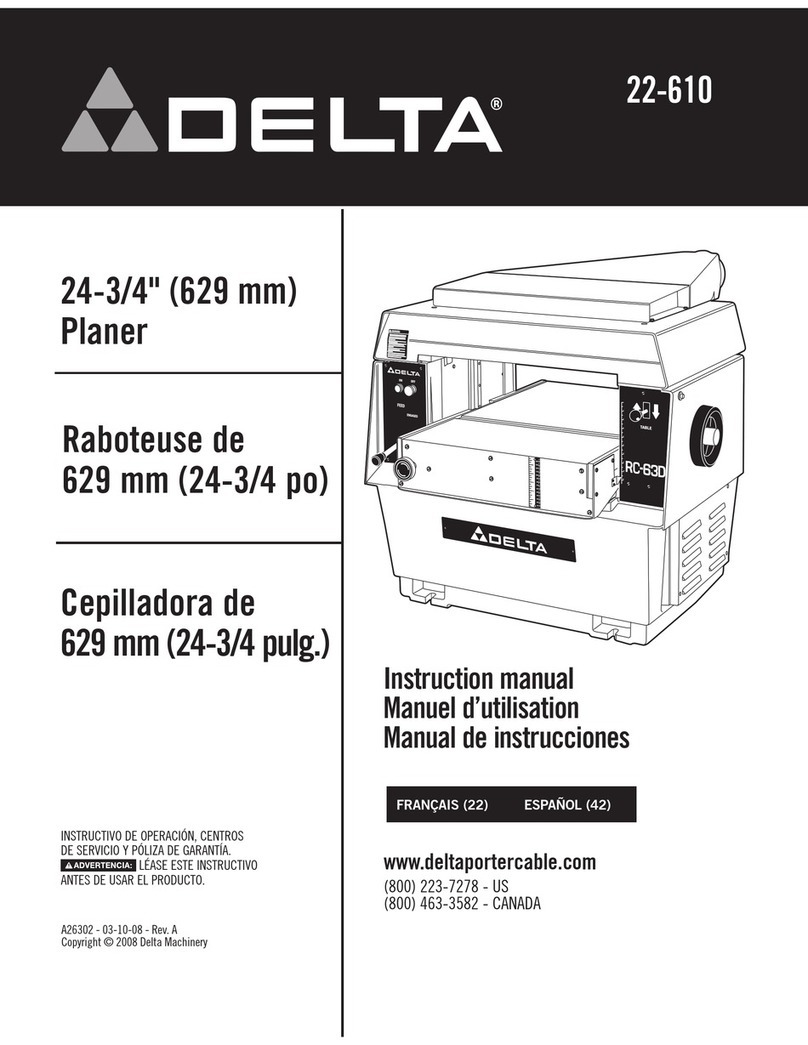
Delta
Delta 22-610 User manual
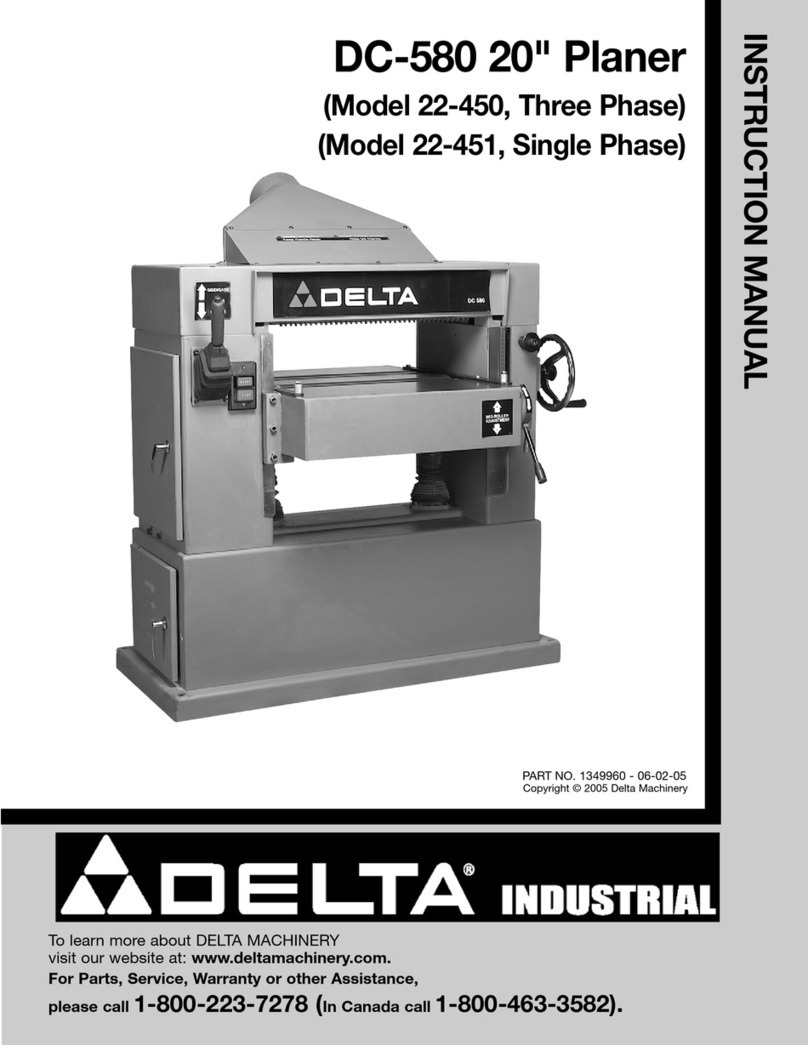
Delta
Delta DC-580 20" PLANER 22-450 User manual
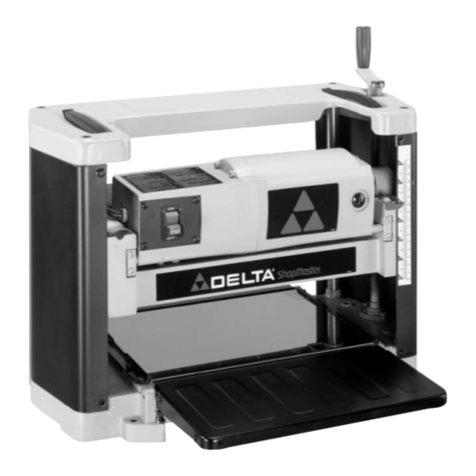
Delta
Delta ShopMaster TP300 User manual

Delta
Delta 22-540 User manual
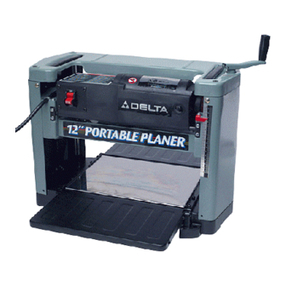
Delta
Delta 22-540 User manual
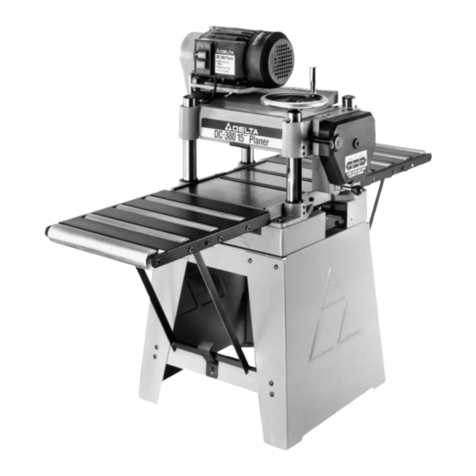
Delta
Delta 22-681 User manual

Delta
Delta 22-790X User manual
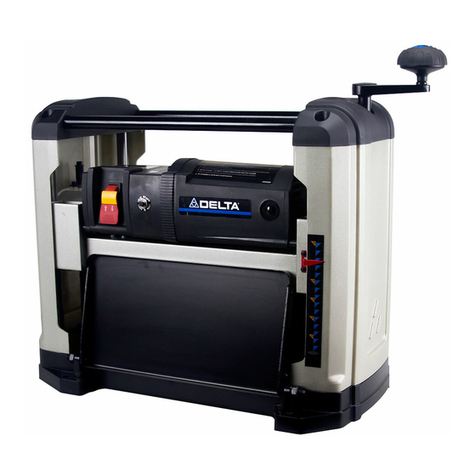
Delta
Delta 22-555 User manual

Delta
Delta 22-580 User manual
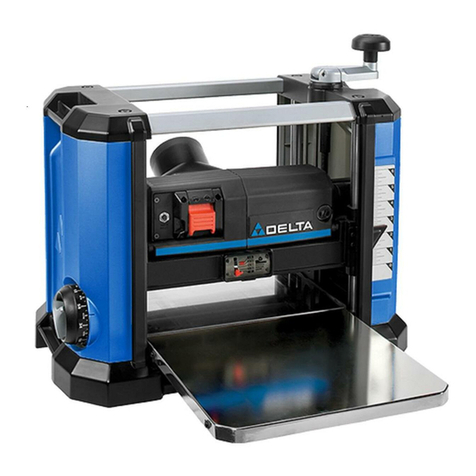
Delta
Delta 13" PORTABLE PLANER 22-590 User manual
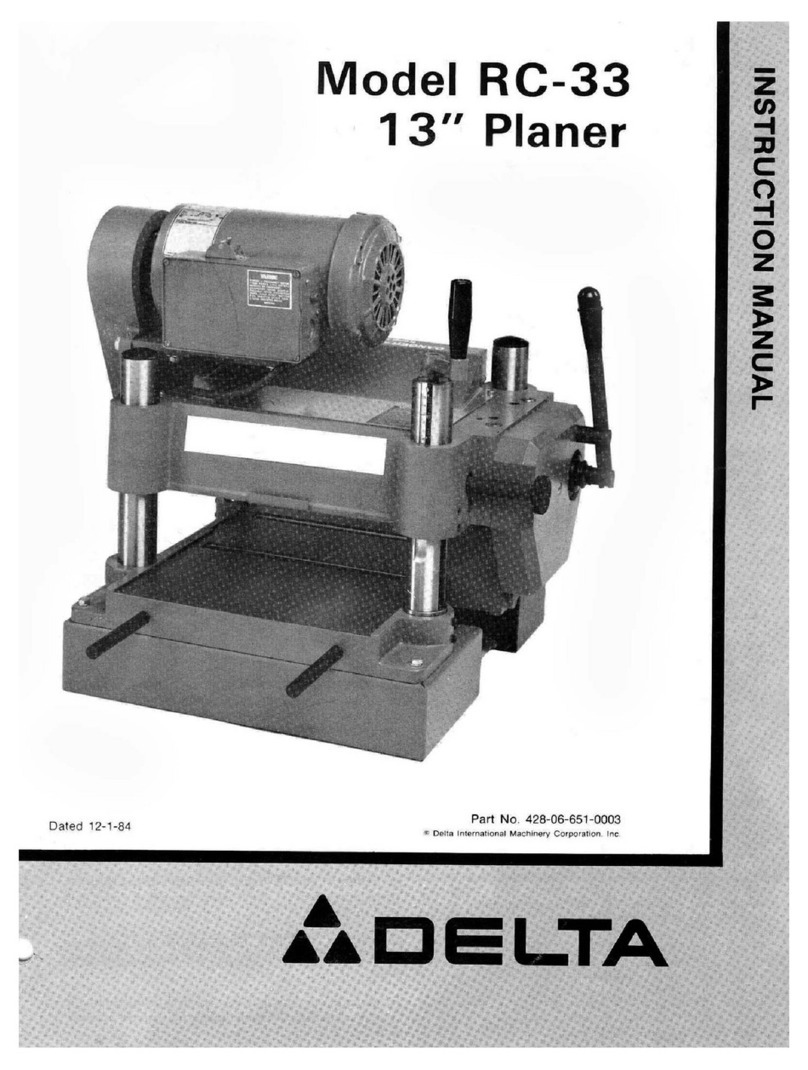
Delta
Delta RC-33 User manual
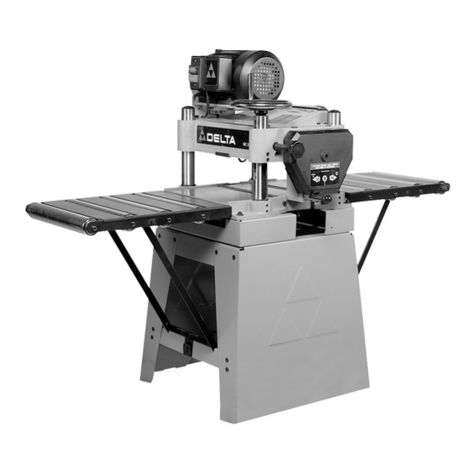
Delta
Delta 22-785 User manual
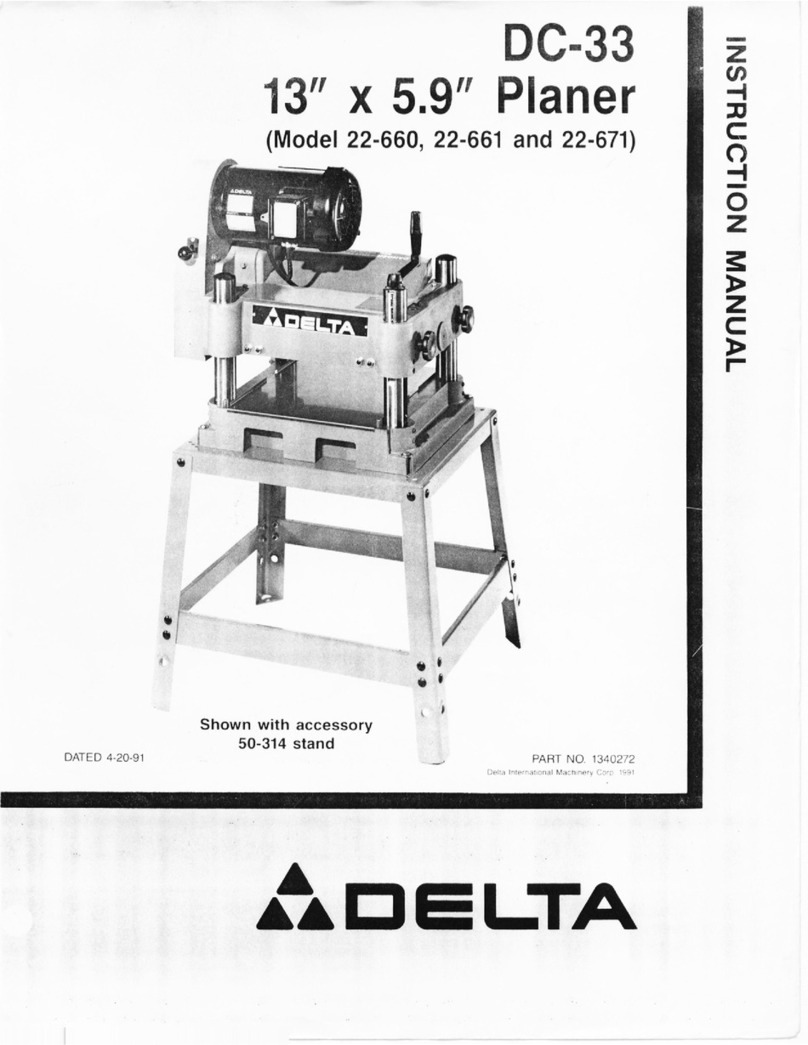
Delta
Delta 22-660 User manual

Delta
Delta RC-51 User manual
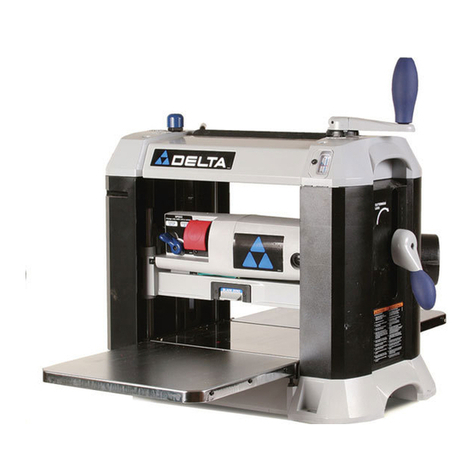
Delta
Delta 18657 User manual
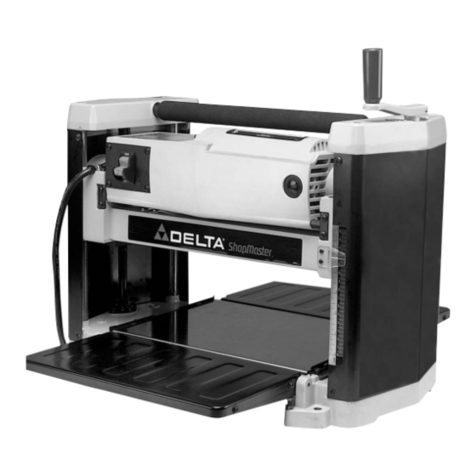
Delta
Delta TP305 User manual
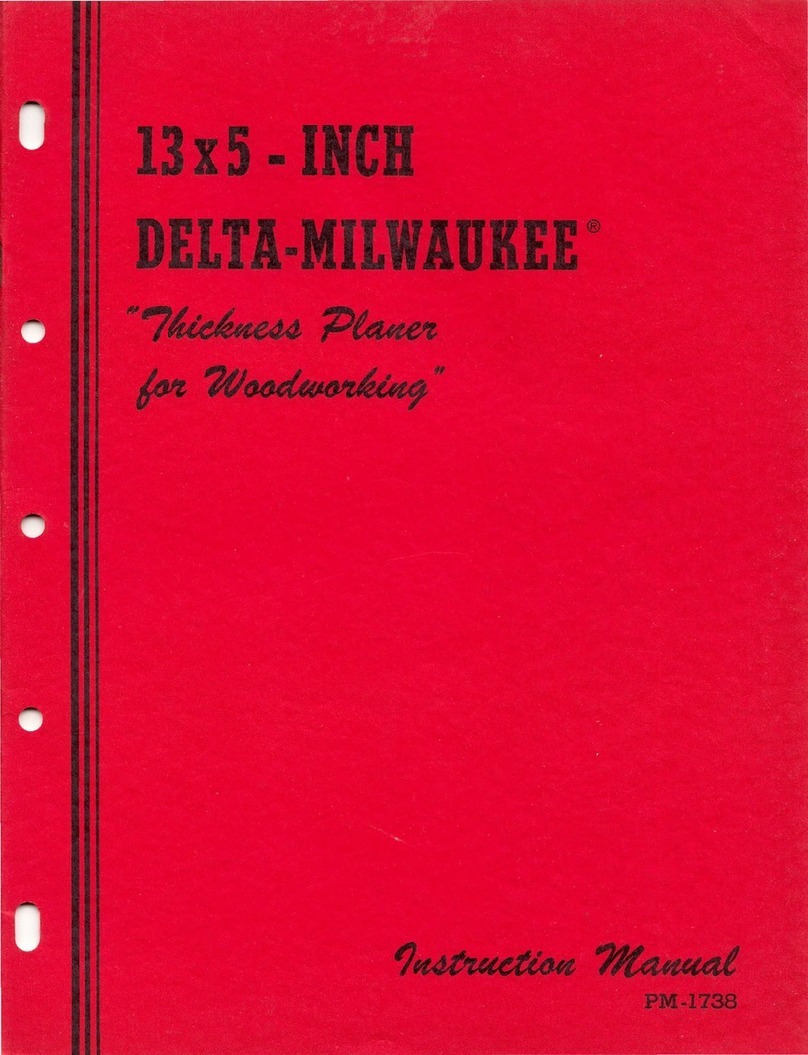
Delta
Delta Milwaukee PM-1738 Manual
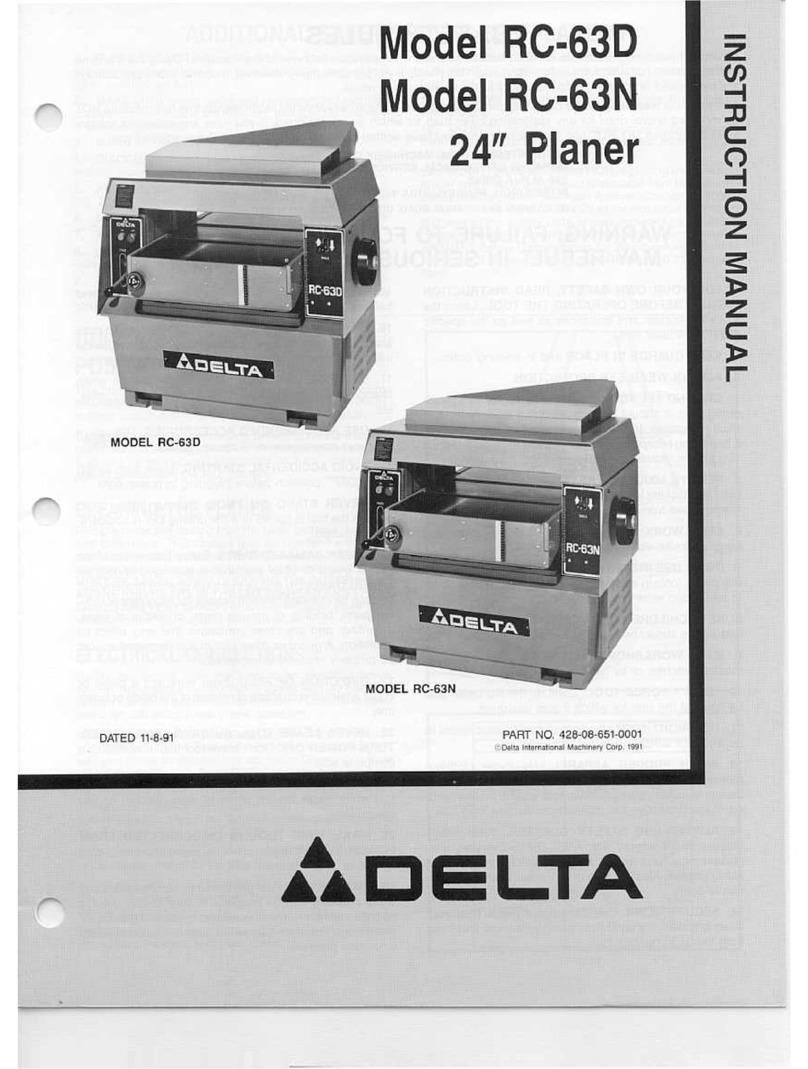
Delta
Delta RC-63D User manual
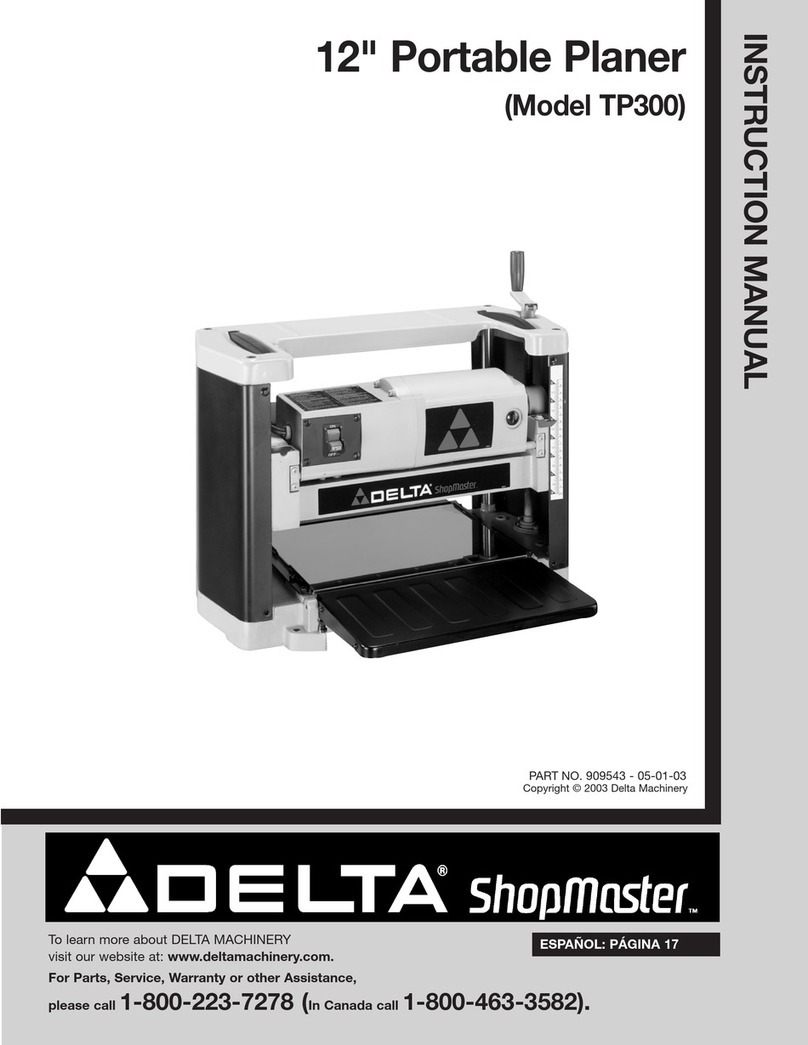
Delta
Delta ShopMaster TP300 User manual

Delta
Delta RC-33 User manual
